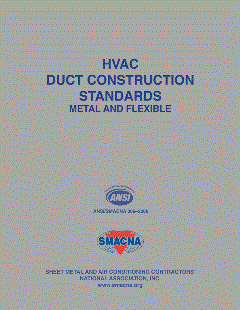Although new materials are introduced from time to time to serve as new HVAC duct system materials, the fact is that nearly all duct insulation products continue to use fiberglass technology, for reasons of safety, cost effectiveness, and performance.

Fiberglass Duct Insulation Types
There are four basic types of HVAC fiberglass insulation products: duct liner, duct wrap, duct board, and flexible ducts. Here is a review of the composition of each:1. Duct liner. Used in the interior of sheet metal ducts, fiberglass duct liner products come as flexible blankets or rigid boards of fiberglass insulation. The airstream surface is formed of either a coating or a fibrous mat. Liners are offered in a variety of thicknesses and density combinations, from 1/2 to 2 inches. Those with tough airstream surfaces resist puncturing, tearing, and surface wear during fabrication, installation, operation, and cleaning. Although most liner products are intended for application in square and rectangular ductwork, products specifically designed for round duct are available. Specifiers can choose between rotary and textile fiberglass insulation. Textile fibers perform well in most applications and provide a strong and durable product. Rotary fibers provide incremental R-value and NRC-value improvement over textile.


4. Flexible ducts. Flexible fiberglass insulated ducts consist of a spiral-wire-reinforced inner air core, wrapped with fiberglass insulation, and jacketed with a vapor-retardant reinforced foil or plastic film. These ducts provide an efficient, economical way to connect trunk ducts and room diffusers or registers. Flexible fiberglass ducts should be used in restricted lengths.

Installation Overview
Details on the installation of all fiberglass duct insulation products can be found in the North American Insulation Manufacturers Association (NAIMA) fibrous glass standards or the Sheet Metal and Air Conditioning Contractors’ National Association (SMACNA) HVAC duct construction standards. The following is a very brief recap of general installation procedures:Duct liner — The products can be precision cut using both manual and automatic cutting equipment, so that all joints are neatly and tightly butted with no interruptions or gaps. The duct liner should be adhered to the sheet metal ductwork using an adhesive meeting American Society of Testing Materials (ASTM) requirements. Next, the liner is further secured to the ductwork using mechanical fasteners, assuring no greater than 10 percent compression of the liner thickness. Some duct liner already provides clean “buttered” transverse edges, although some circumstances may require the use of adhesive to “butter” raw, exposed liner edges.
Duct wrap — Before installation of duct wrap begins, the sheet metal ducts should be clean, dry, and sealed. Wrap is cut to “stretch out” dimensions, which require the measurement of the duct perimeter, with the addition of extra wrap that will form an overlapping stapling and taping flap. The insulation is wrapped around the perimeter of the duct, with the facing out, while adjacent sections are tightly butted with an overlapping flap. Seams are stapled. Where a vapor retarder is required, all seams, joints, tears, punctures, and/or other penetrations of the wrap are sealed with a pressure-sensitive vapor retarder tape.
Duct board — Fiberglass duct board systems can be fabricated in either a shop or on the jobsite. Once cut to the required size, fiberglass duct sections are first stapled closed. The next step is sealing joints, using either UL-listed pressure-sensitive foil tape, UL-listed heat-activated aluminum foil tape, or UL-listed fiberglass fabric or mastic when the duct system is part of a fire-rated assembly. More detailed fabrication and installation instructions can be obtained that are in accordance with NAIMA or SMACNA fibrous glass duct construction standards.
Flexible duct — Since there are several types of flexible duct, it is best to follow the manufacturer’s instructions on recommended maximum length of duct sections, connections, locations, and support systems. SMACNA’s HVAC Duct Construction Standards - Metal and Flexible provides full and detailed instructions on proper installation and can be obtained at www.smacna.org.

Fiberglass Duct Insulation And IAQ
In 1994, OSHA issued the first federal proposal for comprehensive regulation of indoor air quality (IAQ). It addressed the 30 percent of all “non-industrial work environments” believed to have IAQ problems. OSHA outlined a detailed inspection and compliance program of maintenance, ventilation, relative humidity, and carbon dioxide control. Its goal was to significantly reduce the incidence of “sick building syndrome” and the bacterial infection known as Legionnaire’s Disease.For everyone from HVAC contractors and designers to building owners and managers, concerns about IAQ have prompted an emphasis on prevention, rather than correction. Independent studies have found there is no link between poor IAQ and well-maintained fiberglass HVAC insulation. Furthermore, most fiberglass insulation ductwork provides the following benefits:
Can be cleaned: The duct board and liner used in HVAC systems have surfaces that can be cleaned with commonly available duct cleaning equipment as outlined in NAIMA’s duct cleaning guide.
Has antimicrobial agents: The airstream surface of many duct liner and duct board products contains an EPA-registered antimicrobial agent in order to reduce the potential of microbial growth that may affect the product. The antimicrobial properties are intended to only protect the product. Fiberglass insulation products comply with ASTM standards for mold growth.
Does not erode: Fiberglass duct board and duct liner are manufactured and tested to handle air conveyance well above normal operating conditions. They will not degrade when exposed to streams of hot or cold air and they do not allow glass fiber to enter the airstream.
Has moisture-repellent properties: Some manufacturers, such as CertainTeed, now feature a moisture-repellent airstream surface enhancement that is significantly more moisture-resistant than previous type of duct insulation. The feature was developed for specifiers who want to alleviate any concerns about moisture that may enter a duct system due to improperly sealed duct joints or poorly installed and maintained duct systems. The breathable surface coating preserves the sound-dampening performance of the insulation by allowing sound waves to pass through the open-cell structure and into the sound-absorbing glass fiber mat.
The best way to ensure that an HVAC system continues to provide quiet air delivery and occupant comfort in a cost-effective manner is to follow a regular maintenance schedule.
David L. Tomchak is industrial marketing manager of CertainTeed Corporation, Valley Forge, Pa. He can reached at david.l.tomchak@saint-gobain.com or at 610-341-7762. For more information on fiberglass duct insulation, visit www.certainteed.com.
Publication date: 06/16/2003









